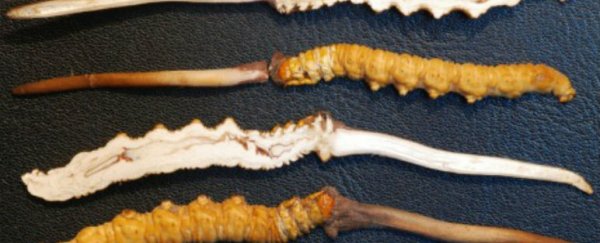A rare species of parasitic fungus has been given a chance to come back from its endangered status thanks to new research that has identified sustainable and peaceful ways of cultivating the much-sought-after commodity.
Said to bring "the delights of thousands of beautiful women" to any man who eats it, the fungus, called Ophiocordyceps sinensis, has been enjoying an almost legendary status among Chinese and Tibetan communities. But its popularity is now so widespread, it's in danger of disappearing altogether.
O. sinensis survives by parasitising the burrowing caterpillar larvae of ghost moths (Hepialus humuli) across the Tibetan Plateau and the Himalayas, high up at altitudes of between 3,000 and 5,000 metres. It's been found in Nepal, Bhutan, Tibet, China, and India.
Every summer, the ghost moth caterpillars shed their protective coatings and move underground to hibernate. Here the fungus will invade a caterpillar's body by infecting it with tiny, air-borne spores. Once inside, the fungus will eat the caterpillar alive, slowly killing and then mummifying it in a vertical position. By early spring, the fungus will emerge right out of the dead caterpillar's head and up through the soil for easy harvesting.
"It's not just for the fun of it. For centuries, people have believed that the fungus known as yartsa gunbu, literally "summer grass, winter worm," is an aphrodisiac," says Lauren Silverman at NPR. "According to ancient Tibetan texts, men who eat it are promised "the delights of thousands of beautiful women." That's why top-quality yartsa sells for around $2,000 an ounce - more than the price of gold. In China, yartsa is a status symbol."
The fungus has become so sought-after, that in 2013, disagreements between Tibetan communities in China led to at least two deaths, while earlier this year, a clash between locals and police in the culturally Tibetan region of Dolpo in Nepal over collection fees left another two people dead.
And it's not just the people we have to worry about. The fungus now holds such immense value - for some local families, it makes up 70 to 90 percent of their income - that its exploitation is now risking the health of the alpine regions that support it.
But the good news is anthropologist Geoff Childs and graduate student Namgyal Choedu from Washington University in the US have identified two villages in the Himalayas that have figured out how to sustainably harvest the valuable fungus - without the risk of violence.
Publishing in the open-access journal Himalaya, the pair document how in Nubri - a mountainous region in the Gorkha district of Nepal - there's a village where the leaders set a specific harvest date for the fungus every year, and in the weeks preceding that date, all the residents of the village are required to check in with the leaders to ensure that no one is sneaking off to take more than their fair share.
Save for a few squabbles, this has been working well so far, they report, because the harvesting areas are several hours away, which means there's no way to sneak out and still make it back to the daily meetings. If you miss just one of the meetings, you'll risk being stuck with a hefty fine.
Most importantly, everyone in the village has the right to collect the fungus, and anyone who does is required to pay tax that will go towards maintaining the village infrastructure. It also means the the species has an entire year to replenish its population.
"Local rituals and certain Buddhist beliefs have helped keep the harvest under control," says Silverman at NPR. "Religious decrees prohibit harvesting on certain sacred mountain slopes. This creates a natural sanctuary, ensuring that part of the landscape will remain undisturbed and allowing fungal spores to spread for the next season."
Residents in a Nepali village, high up in the Tsum Valley, are using the profits gained from harvesting yartsa gunbu to build special lodges for foreign tourists, which is bringing even more money in for the locals, and they've been trading in their fungus supplies for gold to sure up their own wealth.
"Tibetans are using the cash to improve their standard of living, and in some cases are reducing dependency on agro-pastoral activities by becoming entrepreneurs," Childs and Choedu report. "Thus, the yartsa gunbu trade is transforming social and economic life in ways that development initiatives in China and the highlands of surrounding nations have been unable to match."
This fungus is such an important part of the economy for the locals who collect it, it's fantastic to see the methods they're using to ensure its ongoing survival.
Big thanks to Cordyceps expert, Daniel Winkler, for the use of his image above. If you're interested in finding your own strange fungi, Winkler is running a Cordyceps Expedition next year from May 23 to June 5. Winkler explains what you'll get to experience on the tour:
"We will explore the alpine Cordyceps habitat around Ganzi in the gorgeous Kham region of East Tibet / West Sichuan, where the valleys are in full bloom at this time. Every Tibetan that can walk is up on the high pastures in camps looking for the precious caterpillar fungus Tibetans know as Yartsa gunbu. We will have plenty of opportunities to explore Kham's rich cultural heritage in the form of temples and other sacred sites. Lots of hot springs await. A report from the Cordyceps expedition visiting Kham is posted online."
Sources: NPR, Himalaya, Mushroaming.com
